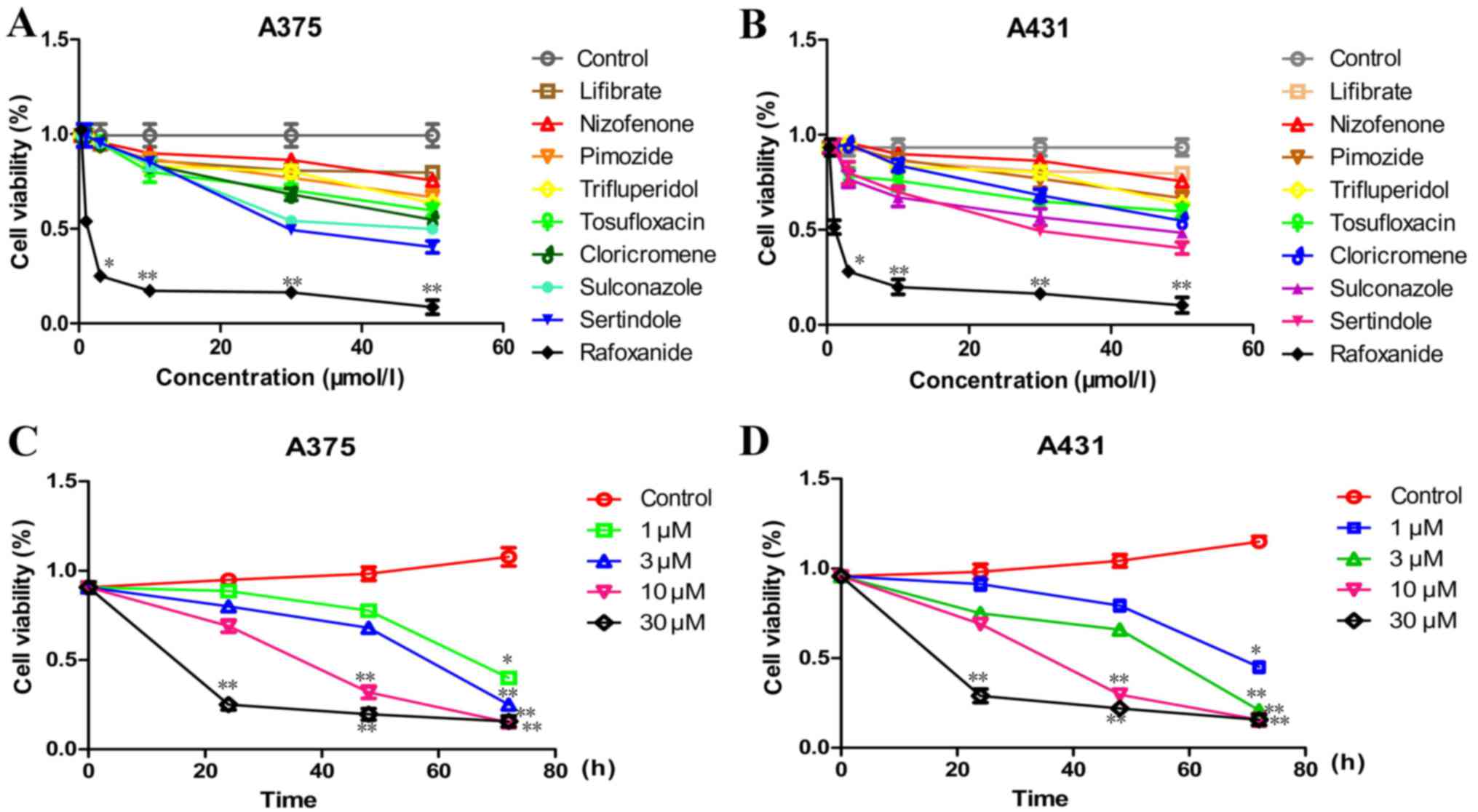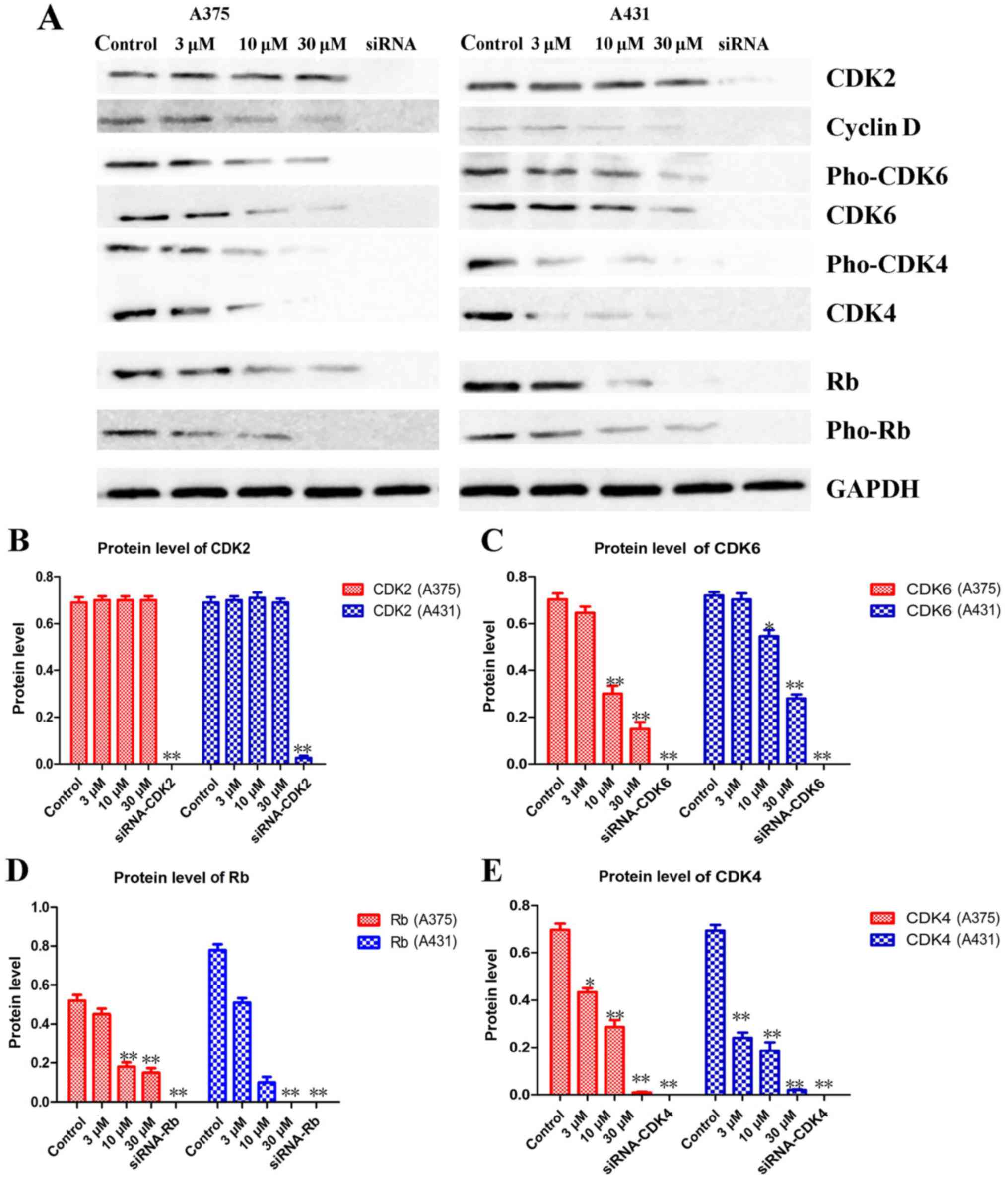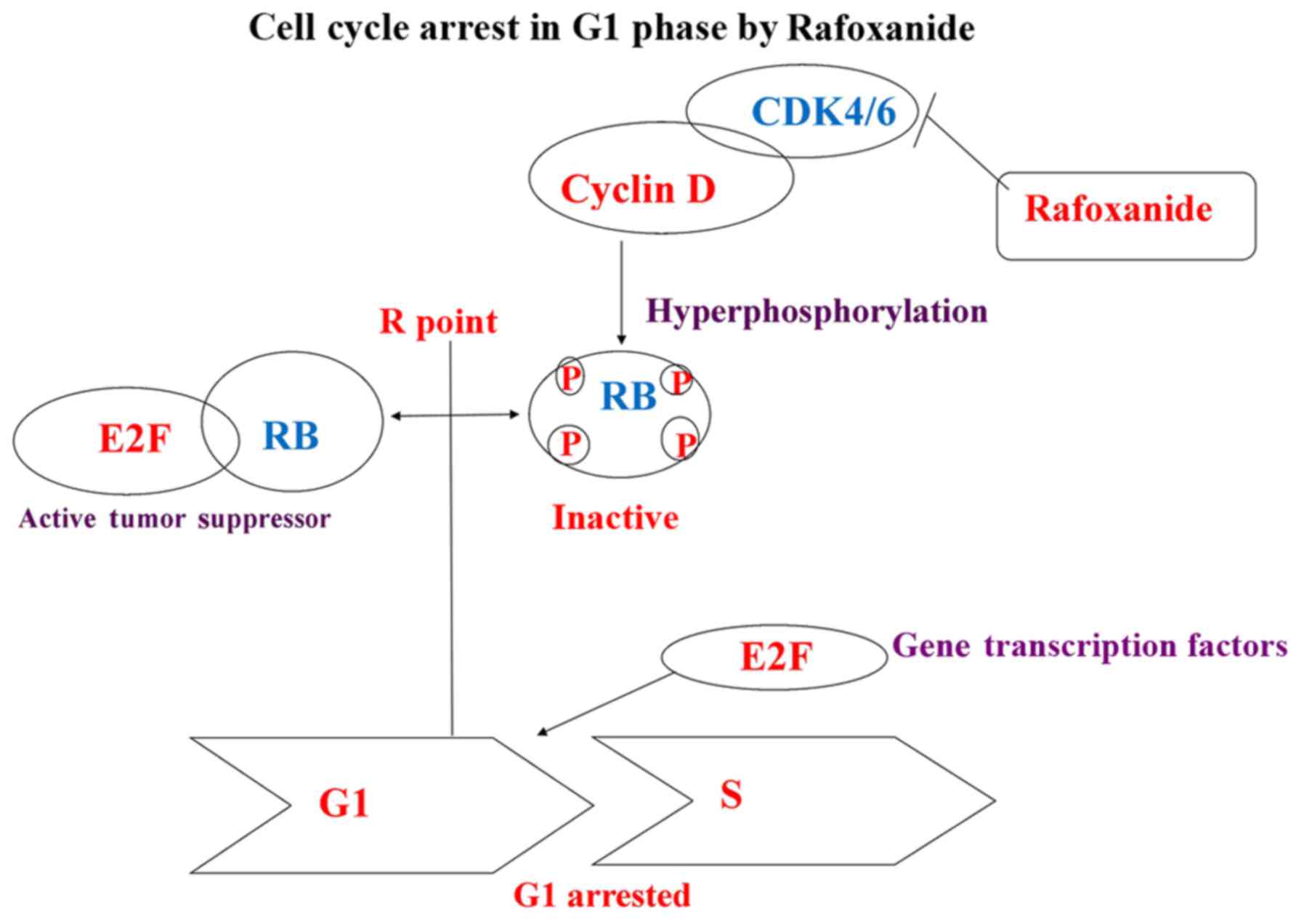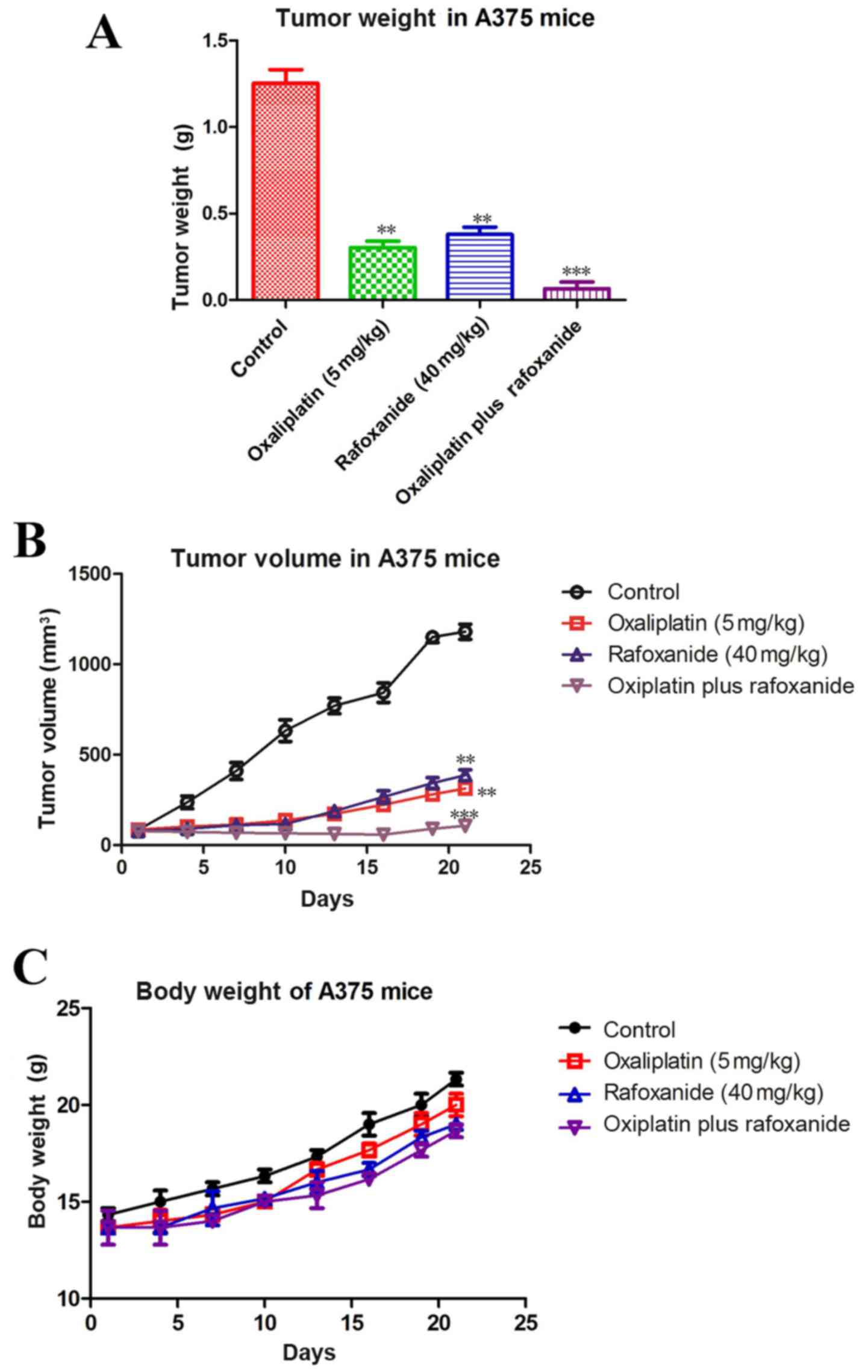|
1
|
Bikle DD, Jiang Y, Nguyen T, Oda Y and Tu
CL: Disruption of vitamin D and calcium signaling in keratinocytes
predisposes to skin cancer. Front Physiol. 7:2962016. View Article : Google Scholar : PubMed/NCBI
|
|
2
|
Fu T, Aasi SZ and Hollmig ST: Management
of high-risk squamous cell carcinoma of the skin. Curr Treat
Options Oncol. 17:342016. View Article : Google Scholar : PubMed/NCBI
|
|
3
|
Lim S and Kaldis P: CDKcyclins and CKIs:
Roles beyond cell cycle regulation. Development. 140:3079–3093.
2013. View Article : Google Scholar : PubMed/NCBI
|
|
4
|
Asghar U, Witkiewicz AK, Turner NC and
Knudsen ES: The history and future of targeting cyclin Dependent
kinases in cancer therapy. Nat Rev Drug Discov. 14:1–146. 2015.
View Article : Google Scholar : PubMed/NCBI
|
|
5
|
Cicenas J, Kalyan K, Sorokinas A, Jatulyte
A, Valiunas D, Kaupinis A and Valius M: Highlights of the latest
advances in research on CDK inhibitors. Cancers. 6:2224–2242. 2014.
View Article : Google Scholar : PubMed/NCBI
|
|
6
|
Canavese M, Santo L and Raje N: Cyclin
dependent kinases in cancer: Potential for therapeutic
intervention. Cancer Biol Ther. l3:1–457. 2014.
|
|
7
|
Lukas J, Bartkova J and Bartek J:
Convergence of mitogenic signalling cascades from diverse classes
of receptors at the cyclin D-cyclin-dependent kinase-pRb-controlled
G1 checkpoint. Mol Cell Biol. 16:6917–6925. 1996. View Article : Google Scholar : PubMed/NCBI
|
|
8
|
Hinz M, Krappmann D, Eichten A, Heder A,
Scheidereit C and Strauss M: NF-κB function in growth control:
Regulation of cyclin D1 expression and G0/G1-to-S-phase transition.
Mol Cell Biol. 19:2690–2698. 1999. View Article : Google Scholar : PubMed/NCBI
|
|
9
|
Weinberg RA: The retinoblastoma protein
and cell cycle control. Cell. 81:323–330. 1995. View Article : Google Scholar : PubMed/NCBI
|
|
10
|
Sherr CJ: Cancer cell cycles. Science.
274:1672–1677. 1996. View Article : Google Scholar : PubMed/NCBI
|
|
11
|
Malumbres M: Physiological relevance of
cell cycle kinases. Physiol Rev. 91:973–1007. 2011. View Article : Google Scholar : PubMed/NCBI
|
|
12
|
Choi YJ and Anders L: Signaling through
cyclin D-dependent kinases. Oncogene. 33:1890–1903. 2014.
View Article : Google Scholar : PubMed/NCBI
|
|
13
|
Pucci B, Kasten M and Giordano A: Cell
cycle and apoptosis. Neoplasia. 2:291–299. 2000. View Article : Google Scholar : PubMed/NCBI
|
|
14
|
Malumbres M and Barbacid M: Cell cycle,
CDKs and cancer: A changing paradigm. Nat Rev Cancer. 9:153–166.
2009. View
Article : Google Scholar : PubMed/NCBI
|
|
15
|
Cohen P: Protein kinase-the major drug
targets of the twenty-first century? Nat Rev Drug Discov.
1:309–315. 2002. View
Article : Google Scholar : PubMed/NCBI
|
|
16
|
Li M, Xiao A, Floyd D, Olmez I, Lee J,
Godlewski J, Bronisz A, Bhat KPL, Sulman EP, Nakano I and Purow B:
CDK4/6 inhibition is more active against the glioblastoma proneural
subtype. Oncotarget. 8:55319–55331. 2017.PubMed/NCBI
|
|
17
|
Dall'Acqua A, Sonego M, Pellizzari I,
Pellarin I, Canzonieri V, D'Andrea S, Benevol S, Sorio R, Giorda G,
Califano D, et al: CDK6 protects epithelial ovarian cancer from
platinum-induced death via FOXO3 regulation. EMBO Mol Med.
9:1415–1433. 2017. View Article : Google Scholar : PubMed/NCBI
|
|
18
|
Malumbres M: Oncogene-induced mitotic
stress: p53 and pRb get mad too. Cancer Cell. 19:691–2. 2011.
View Article : Google Scholar : PubMed/NCBI
|
|
19
|
Sheppard KE and McArthur GA: The cell
cycle regulator CDK4: An emerging therapeutic target in melanoma.
Clin Cancer Res. 19:5320–5328. 2013. View Article : Google Scholar : PubMed/NCBI
|
|
20
|
Shi XN, Li H, Yao H, Liu X, Li L, Leung
KS, Kung HF and Lin MC: Adapalene inhibited the activity of
cyclin-dependent kinase 2 in colorectal carcinoma. Mol Med Rep.
12:6501–6508. 2015. View Article : Google Scholar : PubMed/NCBI
|
|
21
|
Shi XN, Li H, Yao H, Liu X, Li L, Leung
KS, Kung HF, Lu D, Wong MH and Lin MC: In silico identification and
in vitro and in vivo validation of anti-psychotic drug fluspirilene
as a potential CDK2 inhibitor and a candidate anti-cancer drug.
PLoS One. 10:e01320722015. View Article : Google Scholar : PubMed/NCBI
|
|
22
|
Li H, Leung KS and Wong MH: Idock: A
multithreaded virtual screening tool for flexible ligand
dockingProceedings of the 2012 IEEE symposium on computational
intelligence in bioinformatics and computational biology (CIBCB).
San Diego: pp. 77–84. 2012, View Article : Google Scholar
|
|
23
|
Li H, Leung KS, Ballester PJ and Wong MH:
Istar: A web platform for large-scale protein-ligand docking. PLoS
One. 9:e856782014. View Article : Google Scholar : PubMed/NCBI
|
|
24
|
Ross DB: Treatment of experimental
Fasciola hepatica infection of sheep with rafoxanide. Vet Rec.
87:110–111. 1970. View Article : Google Scholar : PubMed/NCBI
|
|
25
|
Elitok B, Elitok OM and Kabu M: Field
trial on comparative efficacy of four fasciolicides against natural
liver fluke infection in cattle. Vet Parasitol. 135:279–285. 2006.
View Article : Google Scholar : PubMed/NCBI
|
|
26
|
Berman HM, Westbrook J, Feng Z, Gilliland
G, Bhat TN, Weissig H, Shindyalov IN and Bourne PE: The protein
data bank. Nucleic Acids Res. 28:235–242. 2000. View Article : Google Scholar : PubMed/NCBI
|
|
27
|
Huang Z and Wong CF: inexpensive method
for selecting receptor structures for virtual screening. J Chem Inf
Model. 56:21–34. 2016. View Article : Google Scholar : PubMed/NCBI
|
|
28
|
Irwin JJ and Shoichet BK: ZINC-a free
database of commercially available compounds for virtual screening.
J Chem Inf Model. 45:177–182. 2005. View Article : Google Scholar : PubMed/NCBI
|
|
29
|
Irwin JJ, Sterling T, Mysinger MM, Bolstad
ES and Coleman RG: ZINC: A free tool to discover chemistry for
biology. J ChemInf Model. 52:1757–1768. 2012. View Article : Google Scholar
|
|
30
|
Arnold A, McAuliff MP and Beyler AL:
Metabolic effects of a new hypolipidemic agent, ciprofibrate. J
Pharm Sci. 68:1557–1558. 1979. View Article : Google Scholar : PubMed/NCBI
|
|
31
|
Matsumoto Y, Aihara K, Kamata T and Goto
N: Nizofenone, a neuroprotective drug, suppresses glutamate release
and lactate accumulation. Eur J Pharmacol. 262:157–161. 1994.
View Article : Google Scholar : PubMed/NCBI
|
|
32
|
Janssen PA, Niemegeers CJ, Schellekens KH,
Dresse A, Lenaerts FM, Pinchard A, Schaper WK, van Nueten JM and
Verbruggen FJ: Pimozide, a chemically novel, highly potent and
orally long-acting neuroleptic drug. I. The comparative
pharmacology of pimozide, haloperidol, and chlorpromazine.
Arzneimittelforschung. 18:261–279. 1968.PubMed/NCBI
|
|
33
|
Bueno JR: Therapeutic evaluation of R2498
(triperidol) in hospitalized schizophrenic patients. J Bras
Psiquiatr. 14:81–91. 1965.(In Italian). PubMed/NCBI
|
|
34
|
Fujimaki K, Noumi T, Saikawa I, Inoue M
and Mitsuhashi S: In vitro and in vivo antibacterial activities of
T-3262, a new fluoroquinolone. Antimicrob Agents Chemother.
32:827–833. 1988. View Article : Google Scholar : PubMed/NCBI
|
|
35
|
Dejana E, de Castellarnau C, Balconi G,
Rotilio D, Pietra A and de Gaetano G: AD 6, a coronary dilating
agent, stimulates PGI2 production in rat aorta ex vivo and in human
endothelial cells in culture. Pharmacol Res Commun. 14:719–724.
1982. View Article : Google Scholar : PubMed/NCBI
|
|
36
|
Lassus A, Forström S and Salo O: A
double-blind comparison of sulconazole nitrate 1% cream with
clotrimazole 1% cream in the treatment of dermatophytoses. Br J
Dermatol. 108:195–198. 1983. View Article : Google Scholar : PubMed/NCBI
|
|
37
|
Muscatello MR, Bruno A, Micali
Bellinghieri P, Pandolfo G and Zoccali RA: Sertindole in
schizophrenia: Efficacy and safety issues. Expert Opin
Pharmacother. 15:1943–1953. 2014. View Article : Google Scholar : PubMed/NCBI
|
|
38
|
Gray-Schopfer V, Wellbrock C and Marais R:
Melanoma biology and new targeted therapy. Nature. 445:851–857.
2007. View Article : Google Scholar : PubMed/NCBI
|
|
39
|
Hanahan D and Weinberg RA: Hallmarks of
cancer: The next generation. Cell. 144:646–674. 2011. View Article : Google Scholar : PubMed/NCBI
|
|
40
|
Walker GJ, Flores JF, Glendening JM, Lin
AH, Markl ID and Fountain JW: Virtually 100% of melanoma cell lines
harbor alterations at the DNAlevel within CDKN2A, CDKN2B, or one of
their downstream targets. Genes Chromosomes Cancer. 22:157–163.
1998. View Article : Google Scholar : PubMed/NCBI
|
|
41
|
Curtin JA, Fridlyand J, Kageshita T, Patel
HN, Busam KJ, Kutzner H, Cho KH, Aiba S, Bröcker EB, Le Boit PE, et
al: Distinct sets of genetic alterations in melanoma. N Engl J Med.
353:2135–2147. 2005. View Article : Google Scholar : PubMed/NCBI
|
|
42
|
Polk A, Kolmos IL, Kümler I and Nielsen
DL: Specific CDK4/6 inhibition in breast cancer: A systematic
review of current clinical evidence. ESMO Open. 1:e0000932017.
View Article : Google Scholar : PubMed/NCBI
|
|
43
|
de Groot AF, Kuijpers CJ and Kroep JR:
CDK4/6 inhibition in early and metastatic breast cancer: A review.
Cancer Treat Rev. 60:130–138. 2017. View Article : Google Scholar : PubMed/NCBI
|
|
44
|
Dean JL, Thangavel C, McClendon AK, Reed
CA and Knudsen ES: Therapeutic CDK4/6 inhibition in breast cancer:
Key mechanisms of response and failure. Oncogene. 29:4018–4032.
2010. View Article : Google Scholar : PubMed/NCBI
|
|
45
|
Bosco EE and Knudsen ES: RB in breast
cancer: At the crossroads of tumorigenesis and treatment. Cell
Cycle. 6:667–671. 2007. View Article : Google Scholar : PubMed/NCBI
|
|
46
|
Tchernev G and Orfanos CE: Downregulation
of cell cycle modulators p21, p27, p53, Rb and proapoptotic
Bcl-2-relatedproteins Bax and Bak in cutaneous melanoma is
associated with worse patient prognosis: Preliminary findings. J
Cutan Pathol. 34:247–256. 2007. View Article : Google Scholar : PubMed/NCBI
|
|
47
|
Stammers BM: The effects of rafoxanide and
nitroxynil on the survival, growth and morphology of Fasciola
hepatica in rabbits. Z Parasitenkd. 46:153–156. 1975. View Article : Google Scholar : PubMed/NCBI
|
|
48
|
Matsubara K, Sanoh S, Ohta S, Kitamura S,
Sugihara K and Fujimoto N: An improved thyroid hormone reporter
assay to determine the thyroid hormone-like activity of amiodarone,
bithionol, closantel and rafoxanide. Toxicol Lett. 208:30–35. 2012.
View Article : Google Scholar : PubMed/NCBI
|
|
49
|
Xie Y, Si J, Wang YP, Li HY, Di CX, Yan
JF, Ye YC, Zhang YS and Zhang H: E2F is involved in radio
resistance of carbon ion induced apoptosis via Bax/caspase 3 signal
pathway in human hepatoma cell. J Cell Physiol. 233:1312–1320.
2018. View Article : Google Scholar : PubMed/NCBI
|
|
50
|
Ma L, Yu HJ, Gan SW, Gong R, Mou KJ, Xue J
and Sun SQ: p53-Mediated oligodendrocyte apoptosis initiates
demyelination after compressed spinal cord injury by enhancing
ER-mitochondria interaction and E2F1 expression. Neurosci Lett.
644:55–61. 2017. View Article : Google Scholar : PubMed/NCBI
|
|
51
|
Zhan L, Huang C, Meng XM, Song Y, Wu XQ,
Miu CG, Zhan XS and Li J: Promising roles of mammalian E2Fs in
hepatocellular carcinoma. Cell Signal. 26:1075–1081. 2014.
View Article : Google Scholar : PubMed/NCBI
|




















